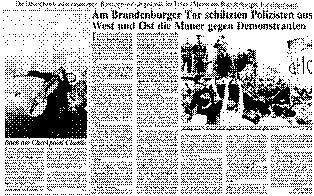 Germans united again / Rostropowitsch Commemorates the Dead / Wall torn down at Potsdam Square
Germans united again / Rostropowitsch Commemorates the Dead / Wall torn down at Potsdam Square
 ,
Monday, November 13th, 1989, p. 5
,
Monday, November 13th, 1989, p. 5
 Germans united again / Rostropowitsch Commemorates the Dead / Wall torn down at Potsdam Square
Germans united again / Rostropowitsch Commemorates the Dead / Wall torn down at Potsdam Square
Twenty-eight years later thousands, predominantly young people, are standing on the wall in front of the Brandenburg Gate. They shout "The Wall must go!", "We want to get in" and "Open the Gate!".
It began a few hours after the announcement of the freedom to travel. Helping hands from above continually pulled people up to the top of the concrete wall. In front of the Brandenburg Gate, which represents both the separation of Germany as well as the desire for unity, the wall is only 8 ft tall, but to everyone's surprise it is about 11 ft thick. A short while ago, none of the demonstrators would have expected to get so close to the Brandenburg Gate.
From here one can see right into the majestic street, Unter den Linden, in the heart of East Berlin. About 200 East Berliners and other curious East Germans were standing there the whole day, looking towards the West. Many were saying it was time that this entrance was opened. In comparison to the West, however, the mood here was more subdued.
On Friday there were initially only 70 members of the DDR Border police standing between the Gate and the Wall itself, looking towards the West. They were young men from 20-25 years old, and their stony glances were beginning to lighten up. For the first time in the history of the Wall they had to prevent a mass attempt to cross from the West.
In true Berliner style, schoolchildren of 10 to 14 years, having received the day off school on this historical day, demanded to be let through. At least some demonstrators had succeeded in penetrating from the West through to Alexanderplatz in the East the previous night.
A Border guard with dark skin became the darling of the occupants of the wall. First he accepted 2 red carnations which a young girl gave him. She had just jumped off the wall into the East. The young man kept the two flowers in his hand for a while. Hundreds of others jumped from the Wall into the East as well, and tried to sprint through the Gate. But all of them were stopped by the East Berlin border guards, and lifted back onto the Wall.
With the coming of darkness, the mood changed. Older demonstrators also appeared on the Wall, and Sekt and Schnapps bottles began to circulate freely.
The East Berlin border troops began to bring in reinforcements. About 300 border guards stood in a long chain. Behind the Gate, which was lit up by car headlights from both East and West, military lorries formed an additional chain. There was a good reason for this: by now there were approximately 200 to 300 young people on the foreground of the Brandenburg Gate, which is still called Hindenburg-Platz as a remnant of the West. The people called up to those standing on the Wall "Jump down! Jump down!". The West Berlin police warned the demonstrators through loudspeakers to be careful. But few people took the threats seriously. Finally, on Saturday at 3 a.m. the Eastern troops began to force the mass of demonstrators back into the direction of the Wall. As that did not seem to work, they tried to pick out individuals every so often and lift them back up.
At the south end of the Hindenburg Platz, where the Wall is 3.5 metres tall, the sounds of hammers were heard for hours. The young people succeeded at breaking off some of the round concrete blocks, and dropping them over into the death strip in the East. As dawn arrived one of the upper parts of a concrete plate reinforced with steel broke off, amid much cheering. It was only when the West Berlin police announced over loudspeakers that "Symbolic removals of the Wall are useless. Please remain calm.", and threatened the use of force, that the thousands hesitatingly retreated. In East and West the area was immediately sealed off with vehicles and the DDR building force closed up the gap in the Wall.
By Saturday morning the government of East Berlin had regained control over this symbolic area of the Iron Curtain. Soldiers in black boots were standing on the East side of the Wall, now also covered in colourful graffiti.
But the demonstrators didn't give up. On Saturday night, thousands stood in front of the Brandenburg Gate again and wanted to get on the Wall. Once again the cry was heard: "The Wall must go!". Tension increased when about 50 aggressive football fans, known as the "Hertha Frogs", wanted to stir up trouble. But the West Berlin police continued to protect the wall with a chain of vehicles.
ANETTE WIRTH/FRANK PAWASSAR